17 Health Benefits of Halasana (Plough Pose) & Steps to Perform
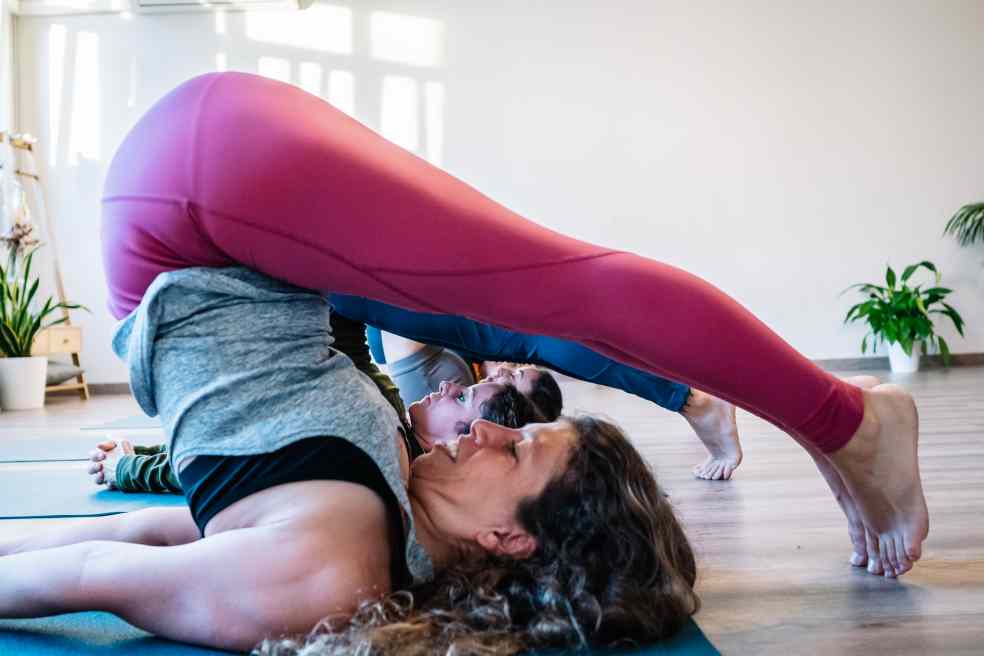
Yoga, a very old Indian practice, has been known and celebrated for its numerous health advantages, including physical, mental, and spiritual well-being. Several yoga poses are there, but one that stands out is Halasana, also called the plow pose.
Halasana is an effective yoga posture that can help make your body flexible and relaxed. For more details about the health benefits of Halasana, keep scrolling through the article.

Table of Contents

What is Halasana?
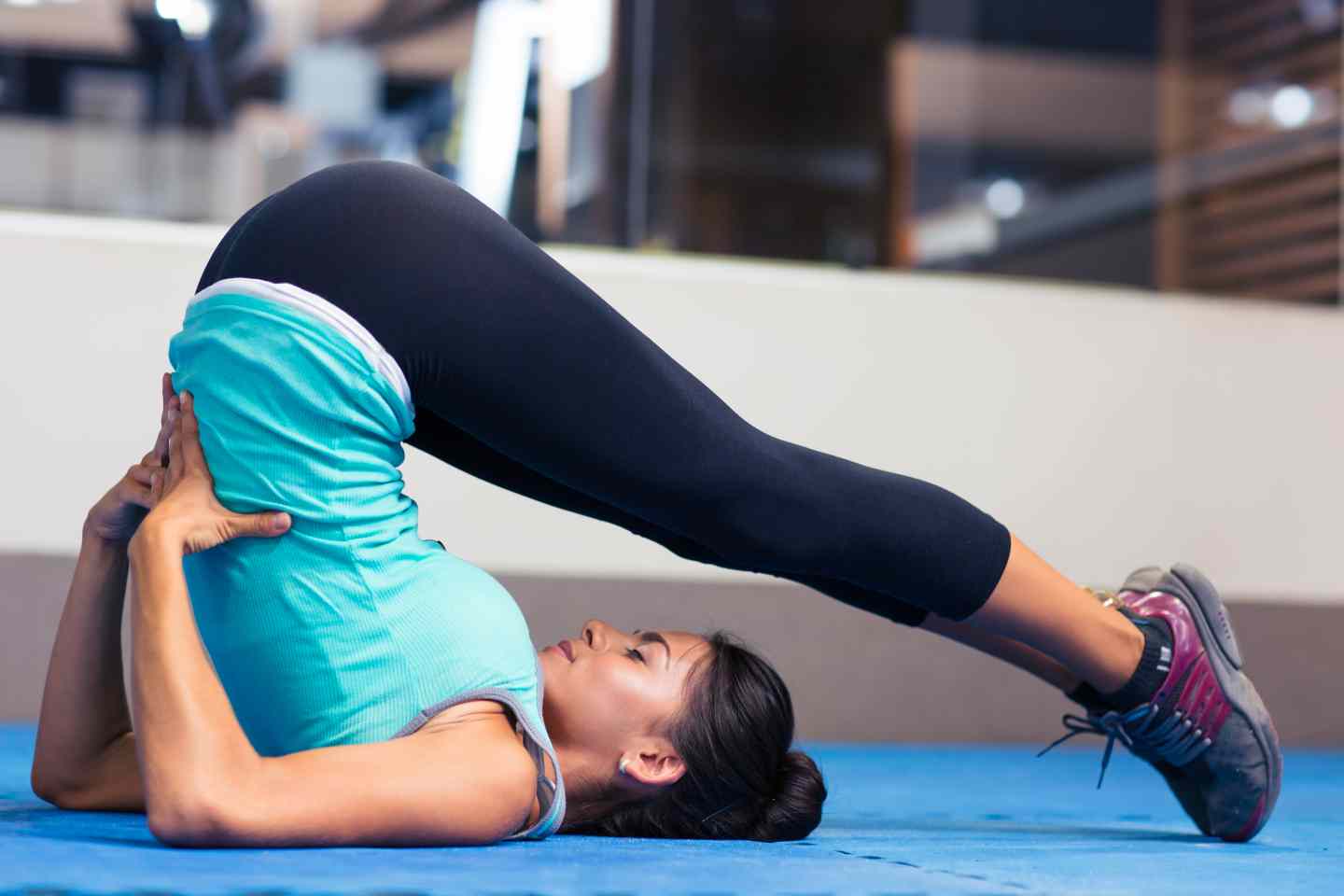
Halasana is the folded and inverted posture of the body, which is primarily considered a finishing pose. In Sanskrit, ‘hala’ means ‘plough’, and ‘asana’ stands for a yoga pose. Therefore, in this yoga posture, your body resembles the shape of a plough, so it is also called a plough pose.
In this posture, you should lie on a surface, lift your legs upwards, and bend over your head while your hands rest by your side. This pose offers various health benefits. To learn more about them, check out the list below.
How Often Can You Perform Halasana?
To fully benefit from the Halasana pose, it is good to practise it often but with a view to the extent of relaxation that suits your body. Ideally, include Halasana in your weekly yoga routine at least 3 or 4 times weekly.
You can begin by holding the posture for about 15-30 seconds before increasing the time when you get used to it. Have 2-3 repetitions in each session while taking deep breaths slowly to remain perfectly aligned. Moreover, always listen to your body without overdoing it, and take enough rest between sessions to recover and avoid injuries.
Top 17 Health Benefits of Halasana
The health benefits of Halasana are as follows -
Physical Benefits of Doing Halasana
1. Helps in Digestion
Halasana is a beneficial yoga pose that puts pressure on your abdomen. Therefore, it helps to boost the function of the stomach and other digestive organs and enhances their activities. People with stomach disorders can get effective help from Halasana.
2. Effective for Thyroid Glands
Halasana is a reverse pose that helps to stimulate blood flow in the extreme upper parts of the body. With proper blood flow, the upper glands, such as the pituitary and thyroid, become active. Further, the endocrine system gets stimulated and functions better.
3. Helpful For Blood Circulation
In Halasana, you need to bend your body backwards so the body gets a reverse posture. Therefore, it helps to reverse blood flow to the edge of all nerves and glands of the body. Therefore, this posture helps to activate the body parts through the proper blood supply.
4. Helps to Deal With Menopause
During menopause, women might feel edgy and stressed as their bodies change. Therefore, in this situation, they need proper care, and Halasana can be helpful, as it relieves stress and tension from major points like the spine, neck and shoulder.
5. Beneficial For Immune System
Halasana is effective for stimulating blood flow, so it boosts the body’s natural protective power for better immunity. Further, it also helps with flexibility and strengthens the spine, resulting in a strong body.
6. Helpful to Reduce Back Pain
Halasana is beneficial for back pain because it allows extreme body bending. Thus, it helps retain the flexibility of the backbone and neck and releases pain and stress from these areas. So, this posture can benefit people suffering from back pain and spine-related issues.
7. Helpful in Managing Diabetes
Halasana helps manage the blood sugar level by restricting the production of excessive blood sugar in your body. Therefore, people with diabetes can perform this posture as a complementary treatment.
8. Effectively Removes Leg Cramps
Halasana or plough pose allows stretching of whole body muscle. Therefore, it can help release muscle pain from different body parts. Bending your waist and legs over your head effectively retains the flexibility of the leg, thigh, and calf muscles. If you face frequent leg cramps, you can surely practise this pose for better help.
Mental Benefits of Doing Halasana
9. Helps to Relieve Stress
Halasana is an effective pose for releasing stress and anxiety. It includes breathing exercises that can help relax your mind. Further, it helps improve blood flow to the brain, boosting its cognitive functioning.
10. Soothes the Mind
Halasana practise cultivates mindfulness and deep breathing, which helps relax the mind and enhance focus and concentration. Consequently, this mental clarity aids in better productivity and making decisions while being mentally more robust than before.
11. Enhances Clear Thinking
For instance, when one does inversions, there is increased blood flow into the brain, which can instigate peacefulness and clear thinking. Increased blood circulation in the brain can help boost cognitive function and memory and improve overall psychological sharpness.
Other Benefits
12. Improves Reproductive System
This yoga pose has been known to improve reproductive system functions by increasing blood supply to those areas, thus alleviating stress. This is important for hormonal balance and reproductive health, associated with stress reduction through enhanced blood flow.
13. Hair Growth Solution
Moreover, when you invert your entire body, even briefly, you bring more nutrients and blood into your scalp, promoting hair follicle growth. Nourishing hair roots using high proportions of such elements helps minimise hair loss while accelerating the regeneration of healthy, thicker strands.
14. Helpful for Increasing Appetite
Stimulating digestive organs and enhancing metabolic functions can help increase appetite. This may be particularly beneficial for those who are dealing with a lack of appetite due to stress, sickness or other causes.
15. Helpful in Reducing Weight
Halasana increases metabolism by stimulating the thyroid gland and improving digestion efficiency. Combining it with a balanced diet and regular exercise will facilitate weight loss and enable one to maintain a healthy body mass index.
16. Helpful Warm-Up for Athletes
Including Halasana in your warm-up routine can boost flexibility, strengthen core muscles, and make you physically ready for sports. With this technique, athletes can prevent injuries, performing better in various games such as athletics, among others.
17. Detoxifies the Body
The inversion also encourages lymphatic drainage and the body's natural detoxification processes. Moreover, by getting rid of toxins and enhancing blood flow, Halasana ensures that general detoxification is achieved, improving health status.
Types of Halasana
Halasana’s basic form can be derived by lying on your back and lifting your legs to meet the floor behind you. Besides that, Halasana has different variations and modifications. Here are a few common types of Halasana:
1. Basic Halasana (Plow Pose)

In this basic version, one lies on their back, lifts the legs and brings them down behind the head until the toes touch the ground. One's arms can lie on the floor or provide extra support for the lower part of the body.
2. Supported Halasana
Halasana may be made to become easier and more comfortable by using props such as bolsters or folded blankets under one’s shoulders, especially for beginners and those who are not flexible.
3. Dynamic Halasana
Instead of being still while maintaining this pose, it involves entering in and out of it dynamically. It is possible to bring one's legs slowly downwards towards the ground before raising them again. Repeating these movements several times can be done.
4. Half Plow Pose (Ardha Halasana)
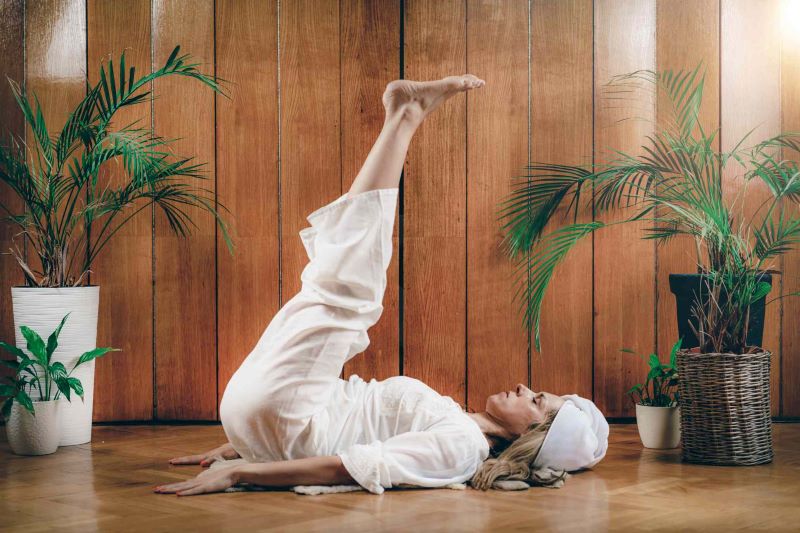
In this variation, one leg is kept straight with the foot resting on the floor while the other leg remains bent but moves down behind the head. This change makes stretching less intense and hence becomes ideal for beginners and people with stiff bodies.
5. Inverted Staff Pose (Urdhva Dandasana in Halasana)
An extended version of an inverted staff pose includes raising arms above the head with palms facing downwards while still balancing on one’s shoulder blades stretching the arms, shoulders and thorax.
6. Twisted Plow Pose
During a twisted plough pose, one can rotate the waist by allowing their legs to fall on one side of their body when in Halasana, which also gives a spinal twist involving extra obliques.
What are the Steps to Perform Halasana?
Following is the step-by-step guide to performing Halasana:
Step 1: Lie on a soft surface on your back
Step 2: Rest your hands by your side with palms downwards
Step 3: Lift your legs at an angle of 90 degrees
Step 4: Keep your breathing pattern regular and slowly lift your waist more with the help of your hands
Step 5: In this way, take your legs over your head and touch your toes to the ground
Step 6: Keep your back perpendicular to the floor
Step 7: Keep your hands by your side and hold the position for 30 seconds
Step 8: Come back to the starting position slowly
Step 9: Repeat the posture 3 to 5 times
Things Required to Perform Halasana

There are a few essential items and considerations that you need to practise Halasana safely and effectively. The following is a list of things needed to perform Halasana:
- Yoga Mat: This comfortable yoga mat has a non-skid surface that provides cushioning and support throughout the pose and a firm ground for your feet.
- Comfortable Clothing: Choose loose-fitting, breathable clothes that allow freedom of movement while practising.
- Quiet and Well-Ventilated Space: Find a quiet space devoid of distractions. This will help you relax during the Halasana.
- Props (Optional): Depending on how flexible or comfortable you feel, props like bolsters, blankets, or blocks can be helpful. They assist in easing the pose.
- Mindful Approach: Always develop mindfulness when doing Halasana. Be aware of your body’s capabilities when performing this yoga pose.
5 Tips For Practising Halasana
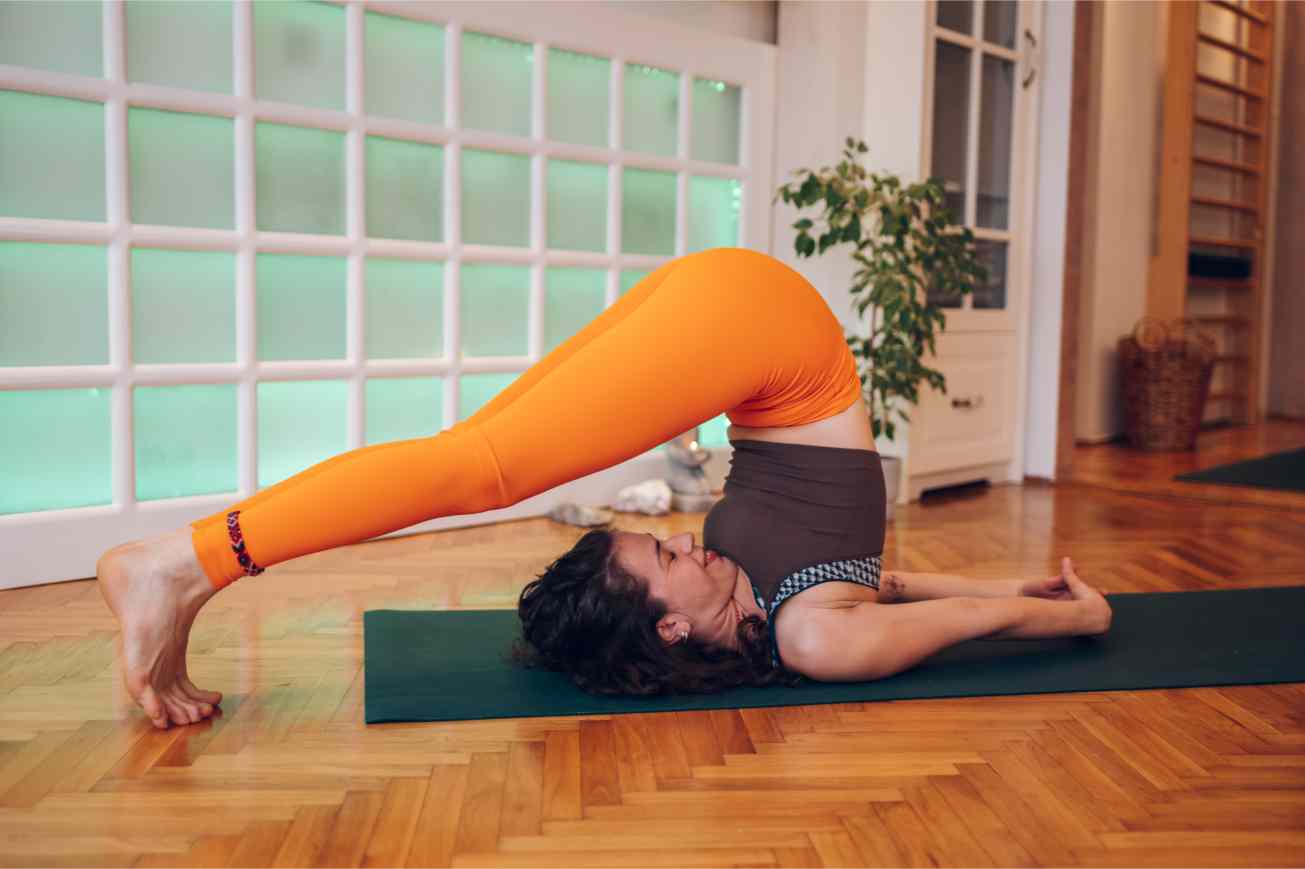
Halasana is very beneficial for different body parts. However, beginners may feel this is tough to perform in one go. For them, here are some practical tips one should know before performing Halasana.
- Follow the Instructions: Yoga posture should only be done with proper instruction. You should take advice from an expert before performing this pose and know how to do it properly.
- Perform the Pose Slowly: The posture involves extreme body bending, which has certain risk factors. Therefore, it is advisable to perform the pose very slowly to avoid injury.
- Keep Your Alignment Intact: Keep your neck and spine in line to avoid faulty posture. Further, while bending your waist over the head, do not put the weight on your neck but your shoulder. To get comfort, initially bend your knees. Further, hold your waist with your hands at the beginning for support.
- Use Props for Support: Beginners who face problems while performing the pose can use various props for support. For example, they can keep a soft blanket or pillow under their neck or hips for better support.
- Perform Other Asanas: Bending the whole body in an inverted direction, you should perform reverse poses to restore your body flexibility. Bhujangasana and Sarvangasana are perfect complementary yoga poses for this.
Precautions and Contraindications of the Halasana
Whether a beginner or an expert, you should maintain precautions to performing any yoga pose. The precautions that you should maintain are as follows -
Do not perform this asana if you haven’t practised yoga posture earlier.
Keep the position for a short time if you face any difficulty.
Avoid practising Halasana if you have a neck injury.
Do not perform Halasana if you already have high blood pressure.
Do not perform it during menstruation or pregnancy.
If you get frequent headaches, do not perform Halasana regularly.
Avoid this posture on days of weakness or fatigue.
What are the Easy Modifications of Halasana?
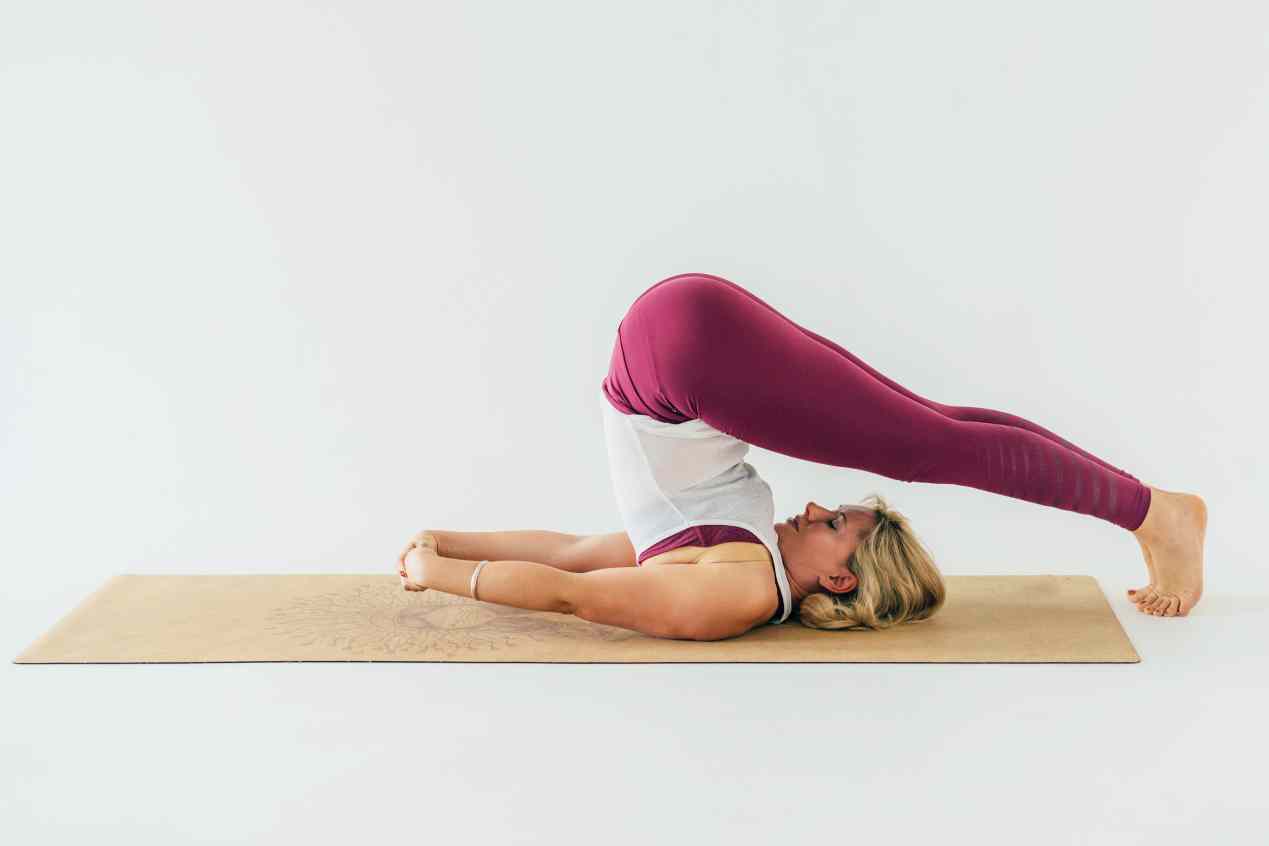
For beginners, some easy modifications of Halasana can help you gain the benefits easily. These are:
- Take Help of Blocks: If your toes can not reach the ground, you can place a yoga block and rest your toes. This will reduce the chance of extreme stretch and help you perform the pose safely.
- Face the Wall: If you can not reach the ground initially, lie by a wall and touch your legs to the wall for support. This will ensure easy grip and relaxed breathing.
- Support Your Neck: Halasana puts extreme pressure on your neck and shoulder blade. Therefore, you can modify the pose by employing a soft blanket to support your neck.
- Go By One Leg at a Time: If you cannot place both of your legs on the ground, then you can do it separately with a single leg with the support of the wall. Then, slowly, when you gain confidence, you can perform the pose as it is.
Who Should Avoid Performing Halasana?
As much as it offers numerous health benefits, not everyone can do Halasana. Some people may not do this pose because they may get hurt or worsen their health conditions. Here are some groups that should refrain from performing Halasana:
- People with Neck or Spinal Issues: These include individuals with long-term neck pain, cervical spondylosis, and other spinal problems, for whom Halasana is contraindicated due to the inversion putting a lot of Cervical Vertebrae pressure and tension on the neck.
- Individuals with High Blood Pressure: People suffering from hypertension should keep away from doing this pose. This means that such an inverted position may increase blood pressure, thereby being risky for cardiovascular patients.
- Those with Glaucoma or Detached Retina: If one has glaucoma or a history of detached retina, Halasana raises eye pressure, which is dangerous for these individuals. The posture could probably make these ocular concerns worse.
- Pregnant Women: Pregnant women should avoid practising Halasana, especially in their last trimester. The inversion and pressure on the abdomen can be harmful to both the mother and the developing baby.
- People with Cardiovascular Issues: Those individuals who have heart ailments like angina and arrhythmia must not do Halasana. This is due to the effort and a flip that causes an excessive burden on the cardiovascular system.
- People with Abdominal or Hernia Problems: Patients diagnosed with gastric issues such as hernias or ulcers should refrain from performing Halasana. The pose presses down into the abdomen area, causing even more trouble for those suffering from these conditions.
- Individuals with Thyroid Issues: It is always good to say that Halasana may activate the thyroid gland. But it is better if people with serious thyroid problems consult their doctors before attempting this move because there are times when it has been contraindicated.
- Older People Who Have Difficulty Moving: Elderly people who cannot move well, have problems balancing themselves or are affected by osteoporosis should avoid doing Halasana to prevent having a fracture. Some old men use this posture since it requires significant flexibility and strength.
- Beginners without Proper Guidance: If you are a beginner, don’t ever try out this pose without someone showing you how it goes. It can cause strains, sprains and other more severe injuries if wrongly practised. Essential, therefore, is learning under the supervision of an experienced yoga instructor.
Halasana enhances flexibility and core strength, reduces stress, and promotes hormonal balance, making it a holistic way of improving one's physical and mental well-being. Whether you’re an advanced yoga practitioner or just starting out, Halasana is proof of how yoga can heal your body, mind, and spirit beyond imagination.













